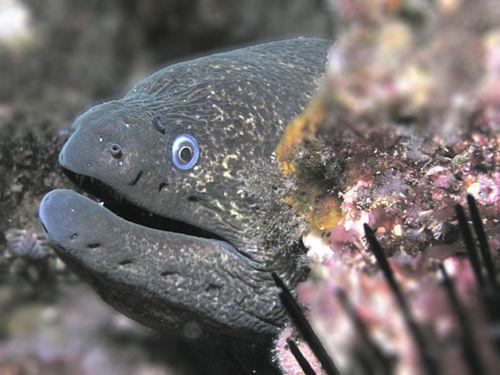 Scuba divers in Thailand are very likely to see a Moray Eel at some point during their dive. Even some snorkellers can see them, but generally they are found deeper than snorkellers descend to. The Giant Moray Eel is just one of many species of Moray Eel found in Thailand. Others are listed below, with detailed descriptions further down this page. All eels are elongated fish that breathe water through gills. Every species of Moray Eel is distinctly different from other types of eel.
Scuba divers in Thailand are very likely to see a Moray Eel at some point during their dive. Even some snorkellers can see them, but generally they are found deeper than snorkellers descend to. The Giant Moray Eel is just one of many species of Moray Eel found in Thailand. Others are listed below, with detailed descriptions further down this page. All eels are elongated fish that breathe water through gills. Every species of Moray Eel is distinctly different from other types of eel.
- Giant Moray Eel (Gymnothorax javanicus)
- Laced / Honeycomb Moray Eel (Gymnothorax favagineus)
- White-Eyed / Grey-Face Moray Eel (Gymnothorax thyrsoideus
- Zebra Moray Eel (Gymnomuraena zebra )
- Fimbriated Moray Eel (Gymnothorax fimbriatus)
- Clouded / Snowflake Moray Eel (Echidna nebulosa)
- White mouth Moray Eel (Gymnothorax meleagris)
- Ribbon Eel (Rhinomuraena quaesita)
What Is A Moray Eel?
A Moray Eel is any member of the Family Muraenidae, in the order of Anguilliformes. They are long, slimy, eels which are the only type of animal currently known to science that have an extra set of jaws not dissimilar to the famous creature in Alien movies. This second set of jaws drags prey into the digestive tract after the teeth of the front jaws have bitten the prey. They range in size from less than 15cm. to 3m. in length. They are found in temperate and tropical seas around the world, and brackish water.
Behaviour : Moray Eels are quite shy creatures that spend most of the daytime in crevices of rocks, coral or other parts of the reef. Generally, they prefer to stay alone, but it’s not uncommon to see two or more Moray Eels sharing a space. However, this may not always be amicable. In order to maintain a flow of oxygen-rich water to pass their gills, they constantly open & close their mouths when not swimming. With their large sharp teeth, this makes them look aggressive when in fact they’re not. They do not have swim bladders, and are therefore not the best creatures for maintaining buoyancy. They have poor eyesight, but an excellent sense of smell.
Feeding habits : All species of Morays are carnivorous, and what each eats depends on its size and opportunities. Generally, they feed at night on crustaceans, cephalopods, reef fish and even other Moray Eels. Feeding at night enables them to find creatures using their sense of smell. Some Moray Eels are known to practice inter-species hunting cooperation. It has been known for Groupers and Moray Eels to work together when hunting.
Breeding : Moray Eels often travel quite far to mate, and do so in strange ways. Sometimes one male & one female will intertwine bodies, but at other times one or more other males may join. In addition, some species can be hermaphrodites, and others change from male to female during their lifetime. Eggs are fertilised outside of the body in warmer-than-normal water.
Life cycle : Moray Eels begin life as Leptocephalus larvae and drift in open water, before they become elvers. They then grow into adult eels and can live for up to 30 years, depending on the species and its conditions. Some species die soon after mating.
Appearance : Moray Eels can be distinguished by a long dorsal fin that is visible from just behind the head all the way down to its tail end. They do not normally have visible pectoral or pelvic fins. Their bodies have smooth scale-less skin, which they cover in special mucus that helps to protect them in several ways. They come in many sizes and colours, from the brightly-coloured yet small Ribbon Eel to the Giant Moray eel, which is the largest species that is quite dull in appearance.
Morays & Humans : If left alone, no species of Moray Eel is any danger to humans. They spend their days trying to hide in crevices but must protrude their heads to get a good flow of water to breathe. Although their mouthing action looks aggressive, it is not at all. Moray Eels always prefer to choose to swim away or hide than to attack a human. Some foolish divers have been known to hand feed Moray Eels but in several cases this has ended in a lost thumb or finger. The reason for this is the eels’ poor eyesight, lack of intelligence and sometimes impatience. Humans occasionally fish Moray Eels but they don’t taste very nice and many contain toxins that can cause illness and even death if eaten by humans.
Which Species of Moray Eels Are Commonly Found in Thailand?
Moray Eels found in Thailand include some common and rare species. Also, most have several common names, depending on who is referring to each species. In addition, there is often confusion about particular common names used for different species in other oceans. For example, there are different species around the world which share the common name of ‘Honeycomb Moray.’ In no particular order, the following species can all be found on Thailand’s west coast, particularly around The Similan Islands & Richelieu Rock.
Giant Moray Eel (Gymnothorax javanicus)
Is the largest and most-common species of Moray Eel to be seen in Thailand. Its size obviously makes it easier to spot, but there appears to be more Giant Morays than other species, anyway. Its colouration is quite dull, and normally a grey/brown. Giant Moray Eels can grow up to 3 metres in length or more, and weigh 30 kilogrammes. Out of the species which humans have interacted with, including hand-feeding, the Giant Morays are also the most common.
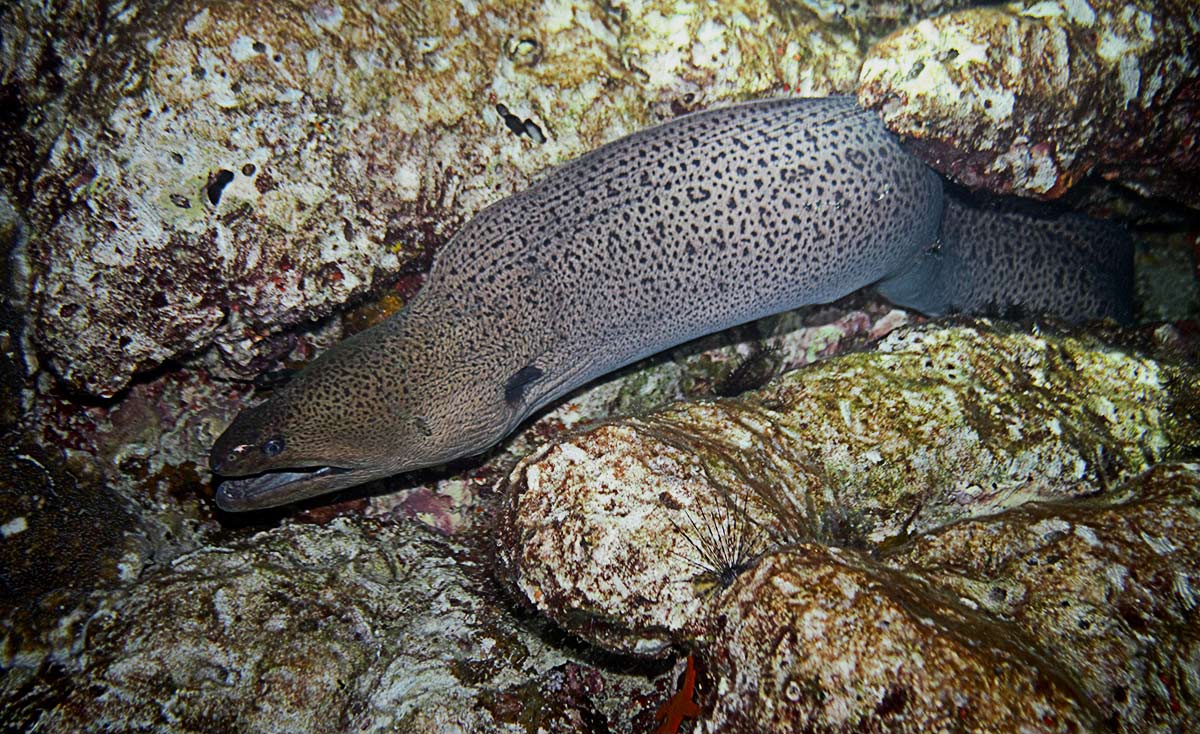 Giant Moray Eel Gymnothorax javanicus feeding at night
Giant Moray Eel Gymnothorax javanicus feeding at night
Laced / Honeycomb Moray Eel (Gymnothorax favagineus)
Is another large species, sometimes growing to nearly 3 metres in length. These eels are very attractive, as they are covered in dark spots like a leopard. In fact, some people also refer to this species as the Leopard Moray Eel. Divers at Boonsung Wreck are guaranteed to see plenty of Honeycomb Morays, regardless of the sea conditions or time of year.
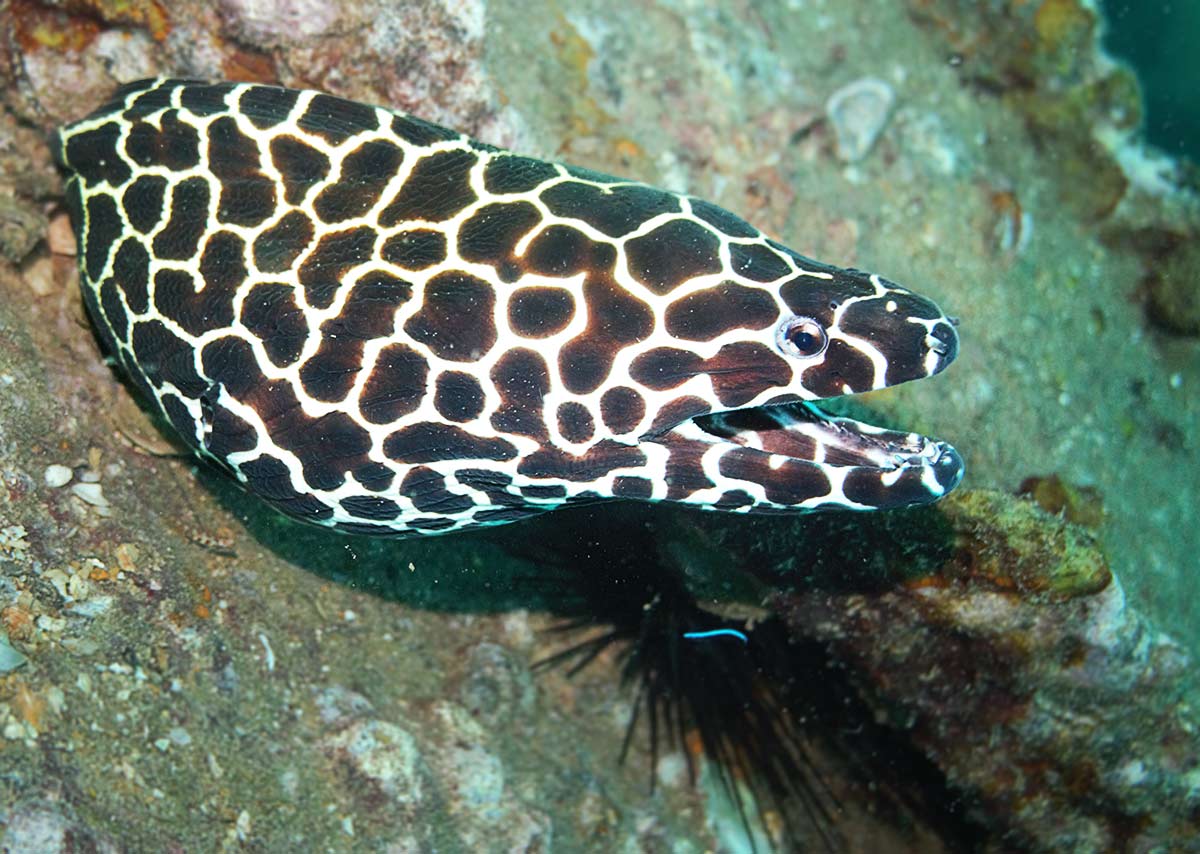 Honeycomb Moray Eel Gymnothorax favagineus at Boonsung Wreck
Honeycomb Moray Eel Gymnothorax favagineus at Boonsung Wreck
White-Eyed / Grey-Face Moray Eel (Gymnothorax thyrsoideus)
Is a smaller species. They rarely grow more than 70cm. in length. White-Eyed Moray Eels are more shy than other species, but can often be seen in pairs, although not mating pairs.
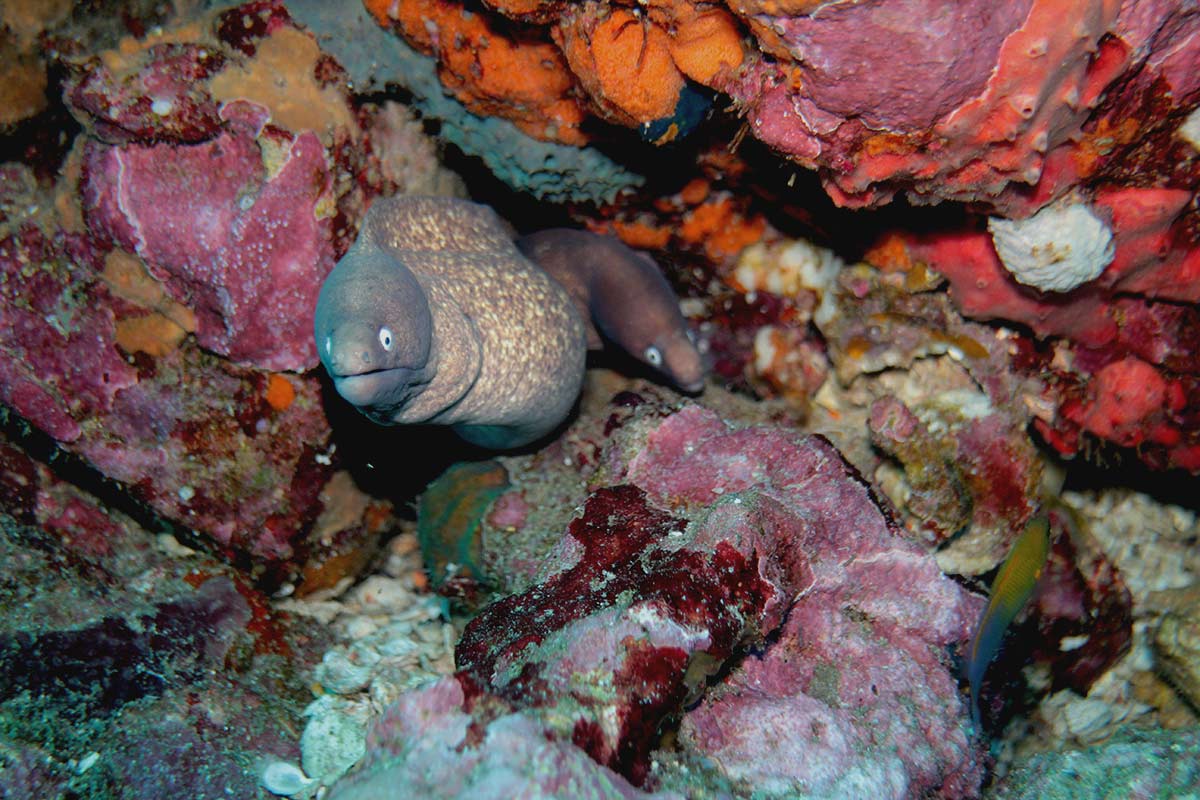 White Eyed Moray Eels Gymnothorax thyrsoideus at Richelieu Rock
White Eyed Moray Eels Gymnothorax thyrsoideus at Richelieu Rock
Zebra Moray Eel (Gymnomuraena zebra)
Is a rare species in Thailand, and often mistaken for two completely different species, the Banded Sea Krait & Snake Eel. Zebra Morays get their name from their black & white stripy patterns all the way down their length. It has short, blunt teeth which are ideal for catching crustaceans and sea urchins. They can grow to more than 1 metre in length, but not often.
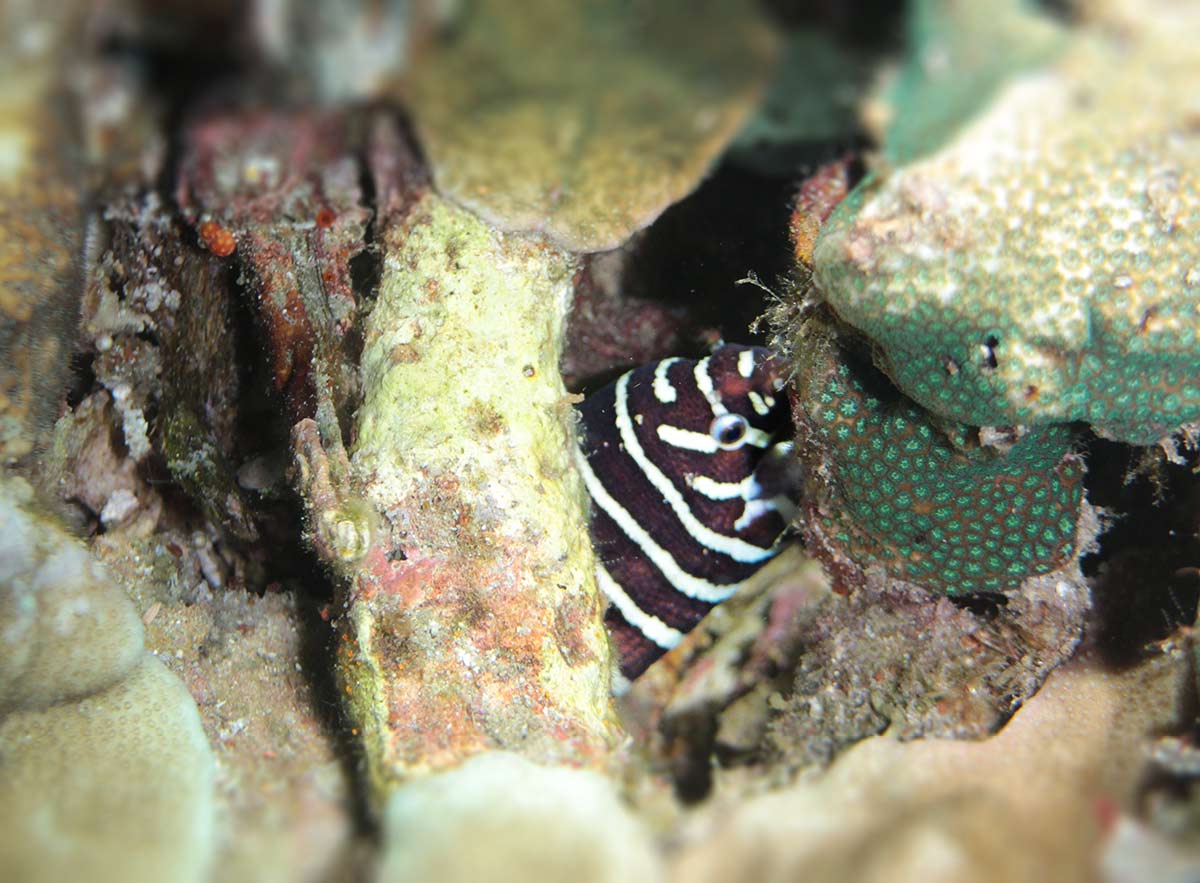 Zebra Moray Eel Gymnomuraena zebra
Zebra Moray Eel Gymnomuraena zebra
Fimbriated Moray Eel (Gymnothorax fimbriatus)
Has a striking appearance. It’s normally bright yellow or green in colour and has a longer snout than most other species. It can grow up to one metre in length over a lifespan up to 18 years. Fimbriated Moray Eels can be found near ports, harbours and in brackish water as well as coral reefs at depths from 7-50m.
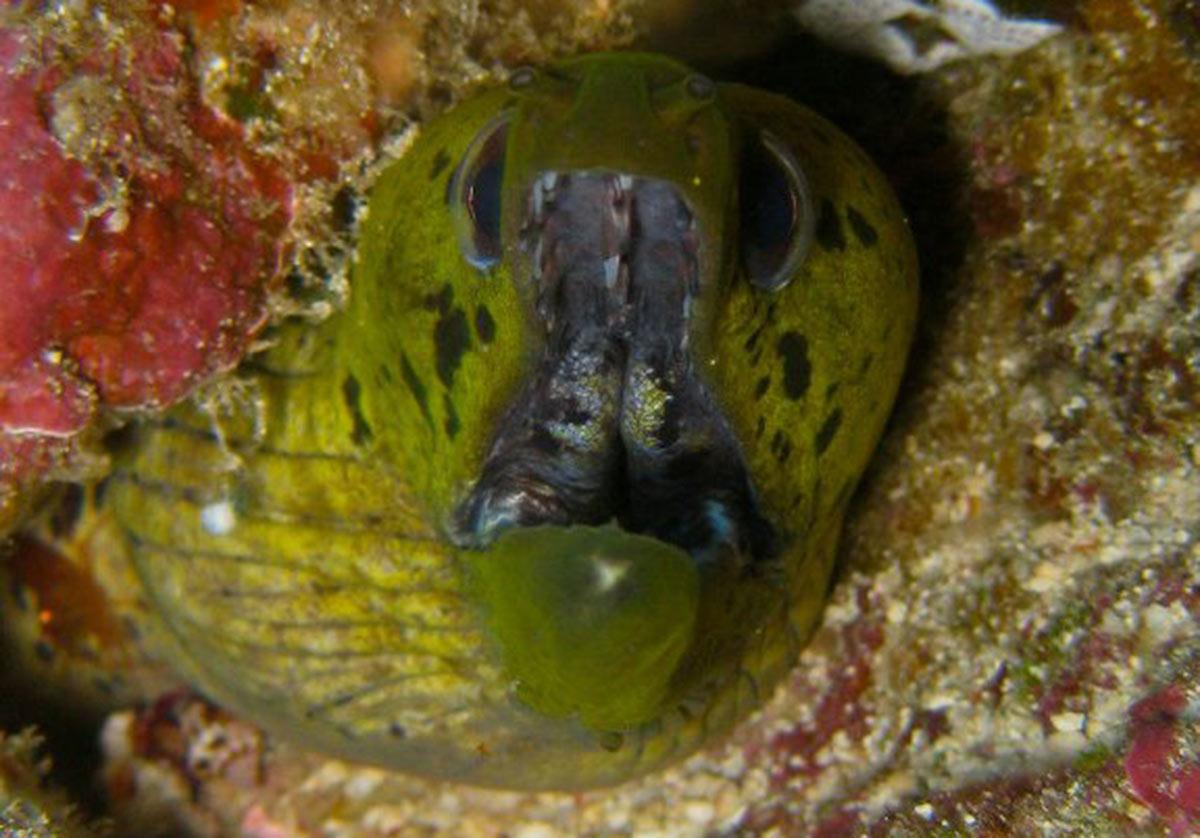 Fimbriated Moray Eel Gymnothorax Fimbriatus
Fimbriated Moray Eel Gymnothorax Fimbriatus
Clouded / Snowflake Moray Eel (Echidna nebulosa)
Is a medium-size Moray, growing up to one metre in length. It is light in colour with two rows of large dark blotches along its sides. They have yellow eyes. Due to their success and hardiness in captivity, Clouded Morays are common and aquarium pet species. However in captivity they do not grow as large or long as in the wild.
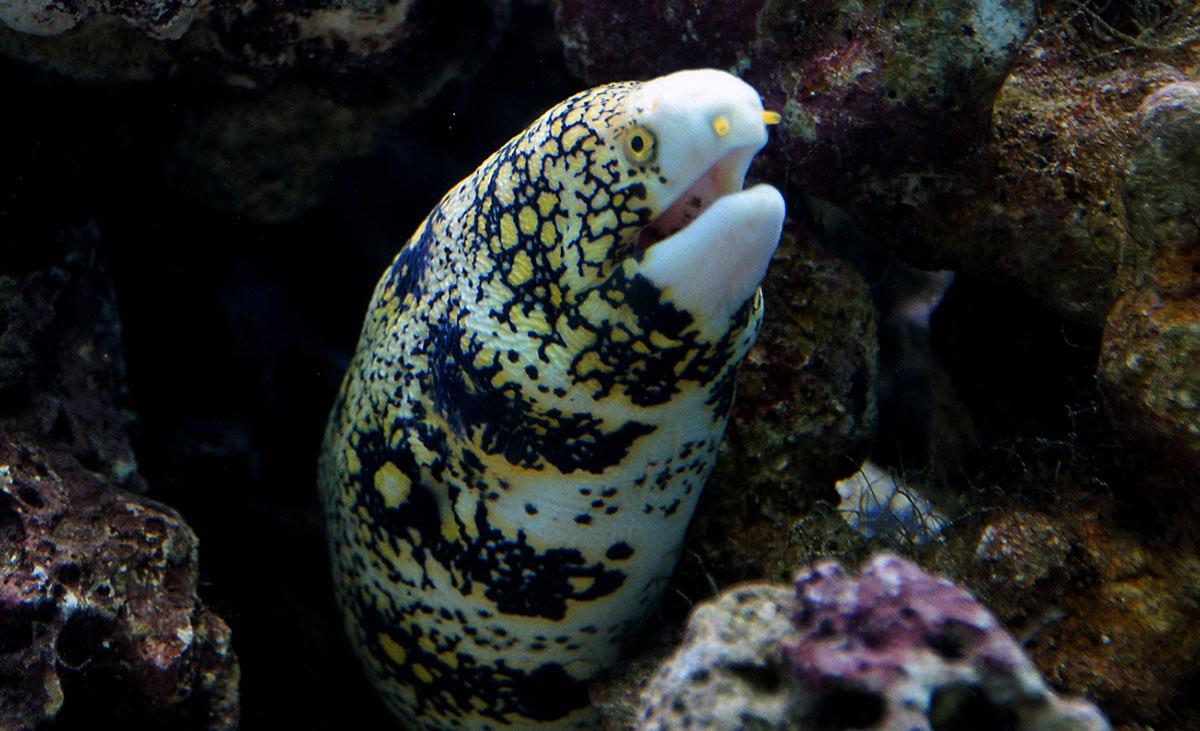 Snowflake Moray Eel Echidna nebulosa
Snowflake Moray Eel Echidna nebulosa
White Mouth Moray Eel (Gymnothorax meleagris)
Is a medium to large species of Moray that has quite dark colouration, but is covered in tiny white spots. Its common name comes from the inside of its mouth being white. It prefers shallower water than most other species of Moray, and juveniles can be seen in knee-deep water. They have quite a large head in comparison to other species.
 White Mouth Moray Eel Gymnothorax meleagris
White Mouth Moray Eel Gymnothorax meleagris
Ribbon Eel (Rhinomuraena quaesita)
Is a very special Moray Eel and different from nearly all others. Its size, shape and colour are all striking. The Ribbon Eel is much slimmer and smaller than other species of Morays in Thailand. It’s a blue and yellow eel (sometimes black or just yellow) that often hides in crevices near sandy bottoms more than in crowded reefs. It’s common to see a Ribbon Eel poking its head and several inches of its body out of a hole in the sand, like a Spotted Garden Eel. It has exposed external nostrils to find prey. It is believed that Ribbon Eels begin life as males and when they change to become females they also change colouration, but this only happens in the wild and is therefore difficult to study.
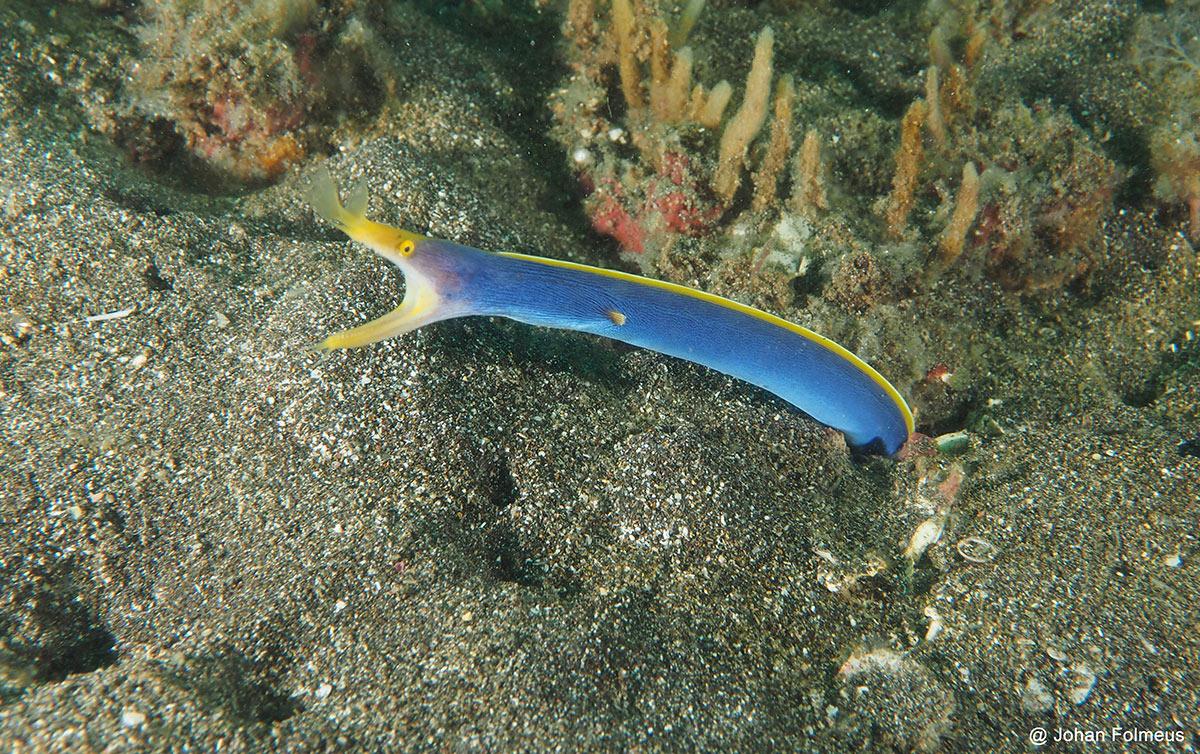
Where Can Divers See Moray Eels in Thailand?
Dive sites in Thailand where you can see Moray Eels are too numerous to list here, but in particular at Richelieu Rock it is almost guaranteed that divers will find at least two species. And nearer to Tab Lamu Pier and often the final stop off for many Similan liveaboard diving cruises, Boonsung Wreck. At Boonsung Wreck there are countless Honeycomb Moray Eels, and anyone diving there who doesn’t see several must be blind, have a fogged mask, or be very distracted. There are individuals of other Moray species at Boonsung Wreck, as well.


